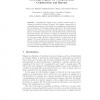Free Online Productivity Tools
i2Speak
i2Symbol
i2OCR
iTex2Img
iWeb2Print
iWeb2Shot
i2Type
iPdf2Split
iPdf2Merge
i2Bopomofo
i2Arabic
i2Style
i2Image
i2PDF
iLatex2Rtf
Sci2ools
103
Voted
ICCSA
2007
Springer
2007
Springer
Modeling Origami for Computational Construction and Beyond
Computational origami is the computer assisted study of origami as a branch of science of shapes. The origami construction is a countably finite sequence of fold steps, each consisting in folding along a line. In this paper, we formalize origami construction. We model origami paper by a set of faces over which we specify relations of overlay and adjacency. A fold line is determined by a specific fold method. After folding along the fold line, the structure of origami is transformed; some faces are divided and moved, new faces are created and therefore the relations over the faces change. We give a formal method to construct the model origami. The model furthermore induces a graph of layers of faces. We give two origami examples as the application of our model. They exhibit non-trivial aspects of origami which are revealed only by formal modelmodel is the abstraction of the implemented core of the system of computational origami called Eos (E-origami system).
Related Content
| Added | 08 Jun 2010 |
| Updated | 08 Jun 2010 |
| Type | Conference |
| Year | 2007 |
| Where | ICCSA |
| Authors | Tetsuo Ida, Hidekazu Takahashi, Mircea Marin, Fadoua Ghourabi |
Comments (0)

